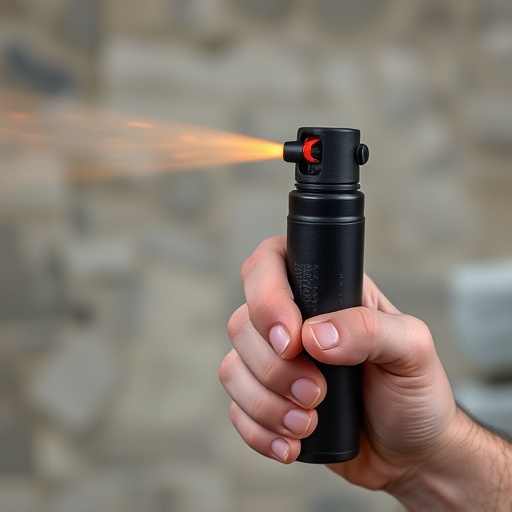Knowing the types and active ingredients in pepper spray, along with proper storage practices (e.g., cool, dry conditions away from direct sunlight), significantly extends its shelf life of up to 3 years. Newer formulations and regular manufacturer quality control ensure consistent potency. Strategic storage methods, including protective cases, preventing contamination, and regular inspections, maximize the spray's effectiveness over extended periods, crucial for civilian self-defense readiness. Responsible disposal of used or expired sprays is also essential.
In today’s world, civilian protection using defensive spray has become an essential tool for personal safety. Understanding pepper spray—its types, active ingredients, and shelf life—is crucial for effective self-defense. This article explores various factors affecting pepper spray shelf life and provides strategies to extend its lifespan. We delve into best practices for storage and use, ensuring you maximize the potency of your defensive spray in civilian protection scenarios. Learn how to make the most of your investment by extending the pepper spray shelf life extension techniques discussed here.
- Understanding Pepper Spray: Types and Active Ingredients
- Factors Affecting Pepper Spray Shelf Life
- Strategies for Extending Pepper Spray Lifespan
- Best Practices for Storage and Use in Civilian Protection
Understanding Pepper Spray: Types and Active Ingredients
Pepper spray is a popular self-defense tool for civilians, designed to temporarily incapacitate an attacker. Understanding its types and active ingredients is key to making an informed choice for personal protection. There are several varieties available, each with unique features and effectiveness levels. For instance, some pepper sprays contain capsaicin, the active ingredient found in chili peppers, while others use more potent chemicals like oleoresin capsicum (OC).
The shelf life of pepper spray is another crucial factor to consider for optimal performance. Many manufacturers recommend replacing it every 2-3 years due to potential degradation of the active ingredients over time. However, proper storage conditions can extend its lifespan. Avoiding exposure to extreme temperatures, direct sunlight, and moisture can help maintain potency. This, combined with a thorough understanding of the spray’s composition, ensures that civilians are equipped with a reliable tool for their safety.
Factors Affecting Pepper Spray Shelf Life
Several factors significantly impact and contribute to pepper spray’s shelf life, ultimately dictating its effectiveness over time. One of the primary considerations is storage conditions—temperature, humidity, and light exposure play a crucial role in preserving the potency of the spray. Optimal storage involves keeping the spray in a cool, dry place away from direct sunlight, ensuring it remains potent for extended periods.
Additionally, the formulation and active ingredients used in pepper spray can influence its longevity. Newer formulations often incorporate advanced technologies to enhance shelf life extension, guaranteeing longer-lasting protection for civilians. Regular testing and quality control measures by manufacturers also contribute to maintaining the spray’s integrity, ensuring it retains its intended potency throughout its intended lifespan.
Strategies for Extending Pepper Spray Lifespan
Extending the lifespan of pepper spray is a smart strategy for civilians prioritizing personal protection. One effective method is to store it in cool, dry places, avoiding extreme temperatures that can degrade its effectiveness. Refrigeration is an excellent option, as it slows down chemical reactions and maintains potency. Keep it away from direct sunlight, which can also accelerate deterioration.
Additionally, proper handling and minimal exposure to air play a significant role in preserving pepper spray’s shelf life. Using protective cases or containers helps prevent contamination and moisture absorption. It’s advisable not to shake the canister unnecessarily, as this can create pressure and potentially compromise its integrity. Regularly inspect the spray for any signs of damage or leakage, ensuring it remains airtight and sealed for optimal performance.
Best Practices for Storage and Use in Civilian Protection
When it comes to civilian protection, proper storage and handling of defensive spray are essential practices for ensuring its effectiveness and longevity. It’s recommended to store pepper spray in a cool, dry place away from direct sunlight or extreme temperatures, as these conditions can accelerate degradation. Keep the spray out of reach of children and unauthorized individuals, using secure locking cabinets or high-up shelves if necessary. Regularly inspect the spray for any signs of damage, leakage, or changes in color or odor, which may indicate reduced potency or impending expiration.
For optimal performance, understand the pepper spray’s shelf life and replacement intervals. Many quality defensive sprays are designed to remain potent for up to 3 years when stored properly, but this can be extended with meticulous care. Always dispose of used or expired sprays responsibly, according to local regulations, and consider purchasing a new one promptly to maintain maximum effectiveness in self-defense situations.
Pepper spray is a valuable tool for civilian protection, but its effectiveness depends on proper storage and usage. By understanding the factors affecting shelf life and implementing strategies to extend it, individuals can ensure their pepper spray remains potent when needed most. Following best practices for both storage and use will help maximize the lifespan of your pepper spray, providing peace of mind and enhanced personal safety. Remember, a well-maintained pepper spray is a powerful ally in navigating potential threats.
